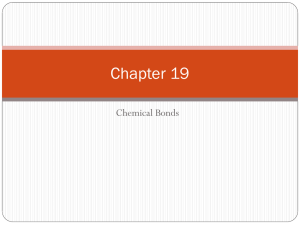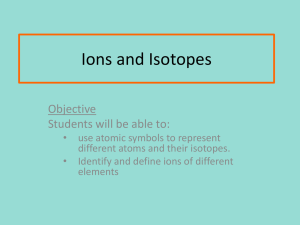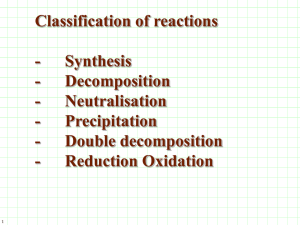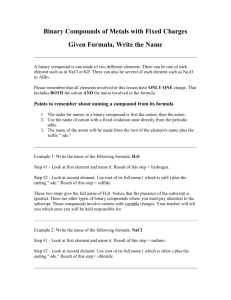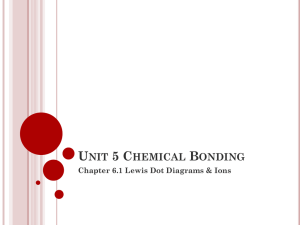Bonding Class #2
advertisement
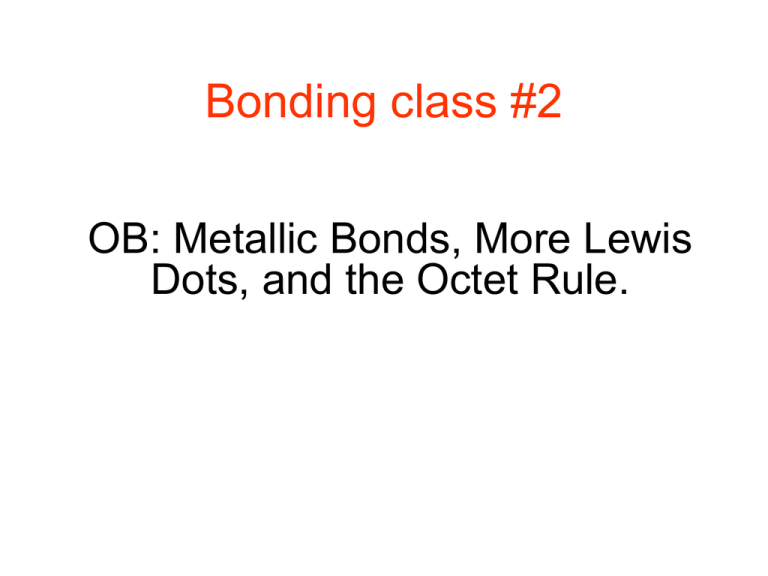
Bonding class #2 OB: Metallic Bonds, More Lewis Dots, and the Octet Rule. When sodium chloride forms from sodium metal and chlorine non metal, the atoms form ions first. To do this, the sodium TRANSFERS an electron to a chlorine atom . The sodium becomes a sodium cation with a +1 charge The chlorine becomes a chloride anion, with a -1 charge Let’s draw the Lewis dot diagrams for the atoms, the ions, and then the compound. ATOMS IONS COMPOUND It’s important to note here, the sodium atom at 2-8-1 electron configuration becomes 2-8 as it loses one electron, becoming isoelectric to neon. It loses enough electrons to get a perfect outer orbital, as defined by noble gases having the most perfect, or most stable electron orbitals of all. The chlorine atom has a 2-8-7 configuration, gains one electron, and becomes 2-8-8, making it isoelectric to argon. Both ions end up with perfect outer orbitals, both end up isoelectric to a noble gas. Both of these ions (all ions) will follow the octet rule: the octet rule is that when bonding all ions will end up with eight outer most electrons, and when bonding, all non-metals bonding together with other nonmetals in covalent bonds, will end up with 8 electrons in the outermost orbitals. This is a rule, but not a law. There are a few exceptions some ions are too small, like Li, Some atoms can squeeze 10 electrons, we love exceptions! Copy this table BIG, leave enough room for the dot diagrams! Compound name Compound Formula Cation Anion Magnesium oxide MgO Mg+2 O-2 LiF CaCl2 Sodium… S-2 Lewis Dot Diagram Copy this table BIG, leave enough room for the dot diagrams! Compound name Compound Formula Cation Anion Magnesium oxide MgO Mg+2 O-2 Lithium fluoride LiF Li+1 F-1 Calcium chloride CaCl2 Ca+2 Cl-1 Sodium… Na2S Na+1 S-2 Lewis Dot Diagram Compound name Sodium… Cesium oxide Compound Formula Cation Anion S-2 Lewis Dot Diagram Compound name Compound Formula Cation Anion Sodium… Na2S Na+1 S-2 Cesium oxide Cs2O Cs+1 O-2 Lewis Dot Diagram Why is the formula for aluminum oxide Al2O3 and not some other ratio? Each metal atom is 2-8-3 and needs to become 2-8 a +3 cation. Follow the octet rule! Al O O Al O Each nonmetal atom is 2-6 and needs to become 2-8 a -2 anion. Follow the octet rule! Why is the formula for aluminum oxide Al2O3 and not some other ratio? Al O O Al O A PERFECT TRANSFER OF ELECTRONS, 6 FROM Al + 6 INTO OXGYEN Draw the UGLY Lewis dot diagram for Magnesium Nitride and also for Al2O3 This kind of bonding is to explain how metal atoms stick together to form solid metals. Literally, how does about 6.02 x 1023 atoms of copper stick together so you can weigh 64 grams of copper on the scale? For the same reason that these atoms can stick together, nearly all of the properties of metals can be explained at the same time. As usual, it’s all about the electrons, where they are, what they’re doing, and how fast they can move. First, let’s name a few properties of metals… Metals are Malleable Ductile Conduct electricity Form cations etc. These main properties can be explained by how we “understand” the metals to be bonded together. Draw this diagram quickly… Metals are understood to exist as packed cations, surrounded by loose valence electrons. These valence electrons can move quickly (near the speed of light) if they have to. The positives balance the negatives since they are all atoms. Protons = electrons. Imagine smashing the metal with a hammer to make the metal exhibit its malleable nature. The cations will be crushed closer together, and would repel, but the loose valence electrons flow to offset this excess positive charge. Same when you squish it into a wire. Imagine a flow of electrons (electricity) in from the left side. As electrons flow into the metal, there are too many negative electrons for the cations, so the excess electrons flow out the other side (the flow of electrons is electricity!). The cations are awash in a sea of loose valence electrons. Hand in bonding home work #1 now. All old work is due asap! Check your grades. Read the Diary!


